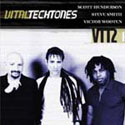Vital Tech Tones 2: Liner Notes
 It's
time to reclaim the f-word. Enough with this
stigma about fusion. That once vital genre --
pioneered in the late '60s by visionaries with
raw passion and a pent-up desire for stretching
-- got scuttled somewhere around the late '70s
by slick, over-rehearsed clones who co-opted the
tag and promptly de-fanged the music in some
lame-o attempt at making nice-nice with radio.
While they still called it fusion, these
purveyors of puerile pap had more in common with
the Archies and Andy Gibb than "The Inner
Mounting Flame" and "Emergency!" They watered it
down, squeezed the life out of it, putting a
friendlier, happy-face spin on it until...voila!
...ten years down the road you get "smooth
jazz." It's
time to reclaim the f-word. Enough with this
stigma about fusion. That once vital genre --
pioneered in the late '60s by visionaries with
raw passion and a pent-up desire for stretching
-- got scuttled somewhere around the late '70s
by slick, over-rehearsed clones who co-opted the
tag and promptly de-fanged the music in some
lame-o attempt at making nice-nice with radio.
While they still called it fusion, these
purveyors of puerile pap had more in common with
the Archies and Andy Gibb than "The Inner
Mounting Flame" and "Emergency!" They watered it
down, squeezed the life out of it, putting a
friendlier, happy-face spin on it until...voila!
...ten years down the road you get "smooth
jazz."
Fast forward to 2000: A kind of
fusion renaissance is in full effect and has
been steadily brewing for years. The signs are
everywhere. Reissues of the Mahavishnu Orchestra
are selling at a startling pace. No less than
five recording projects have recently surfaced
in which bands pay tribute to Miles Davis's
highly provocative electric period of the early
'70s. An online fusion magazine
www.fusemag.com has emerged
with a full-blown member base. Meanwhile, a
whole host of renegades is going against the
grain with their own brand of vital,
aggressively virtuosic fusion music. It's a
two-pronged attack:
On the one hand,
there are the 40-something musicians who came up
with the likes of Tony Williams Lifetime,
Mahavishnu Orchestra and Return To Forever. Out
of sheer frustration -- and not a small dose of
nostalgia -- they are returning to their roots
and blowing with abandon once again. Count RTF's
Lenny White and Stanley Clarke in that number.
Last year they formed the powerful fusion band
Vertu as just such a stretching vehicle.
On the other hand, there is a growing legion of
accomplished 20-something players who are just
now discovering the high energy joys of fusion's
golden era and are forming bands to pick up on
what those pioneers were putting down 30 years
ago. What comes around goes around, indeed.
The message to musicians is clear: it's safe
to play again. We, the audience, can handle
whatever you throw at us. So don't pander with
sonic pablum anymore. No need to browbeat us
with obvious, blatantly-stated 4/4 backbeats. Go
ahead, imply time. Mix up the meter a bit. And
above all, don't repeat that nifty melodic
nugget again and again and again...as if
teaching a child "Row, Row, Row Your Boat."
Follow instead the lead of Vital Tech Tones,
a band of three virtuosos who put a premium on
pushing the envelope and challenging listeners
in the process. They threw down the gauntlet in
1998 with their self-titled debut, establishing
that initial chemistry while boldly stating
their intentions: "We came to play." They
explode out of the box on this kinetic follow-up
for Tone Center -- the fusion label started up
by metal maven Mike Varney -- taking it up a
notch in terms of energy, interplay and
open-ended stretching.
"The thing we
really focus on in this band is the virtuosity,"
says ringleader Steve Smith, the versatile
drummer who broke in with Jean-Luc Ponty in the
'70s before joining rock supergroup Journey and
later founding Vital Information. "That's
something we bring to the forefront for
ourselves and we use that to coax each other, to
push each other to those heights. With Vital
Information I'm not so concerned with virtuosic
playing. We have more of an overall sound that
we're putting across so we're focusing more on
the vibe of the tunes. We have solos but
virtuosity is not an over-riding concern. It is
with this band."
Like the process for the
first album, most of the tunes on this follow-up
started with some drum ideas that Smith had
worked up and presented to bassist Victor
Wooten, who would then develop a groove. After
establishing a rhythmic foundation, guitarist
Scott Henderson would embellish with harmonic
and melodic ideas. "Each tune took a day from
conception to completion," Smith explains, "so
it was a process of composing-rehearsal-
performance that happened all in one day.
"It's a real natural chemistry," Smith adds.
"We have a lot of fun, a lot of laughs, a lot of
respect for each other. When we get into the
process, we'll have disagreements, but
everybody's good about it. We'll work it through
until the music presents itself. Sometimes it's
a bit of a challenge to get everybody's ideas
heard, but it's usually pretty obvious which
ideas are going to work."
"The main thing
that I hear on both of these Vital Tech Tones
records," says Wooten, "is that the three of us
actually have a sound. When you put them on, it
really sounds like a band. There's a definite
chemistry there and it seems to have gone on to
another level on this record. I think we were
much more comfortable with each other, we knew
more about what to expect."
-
Adapted from the VTT2 liner notes by Bill
Milkowski

Click here to return to the top of the
page. |
|

Use the
navigation
buttons,
below,
to shop
for
specific
kinds of
products.
Questions?
Write
to:
custserv@vitalinformation.com
Click
here
to
return
to the
Fusion
store
page. |
|

